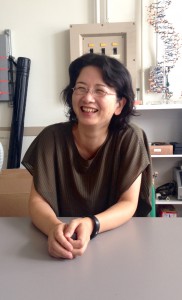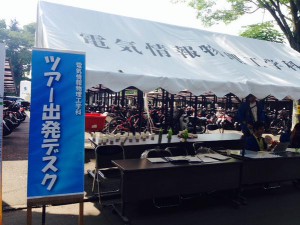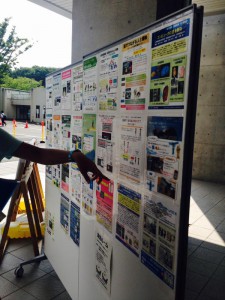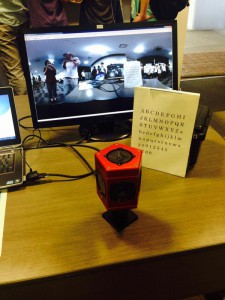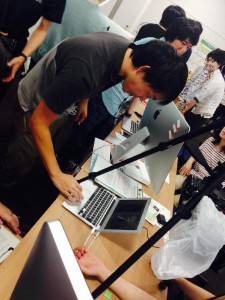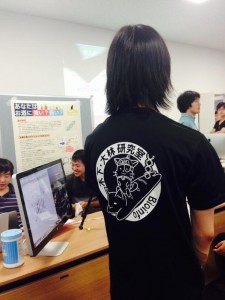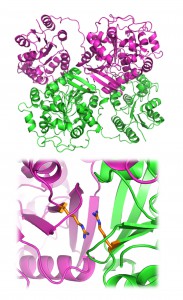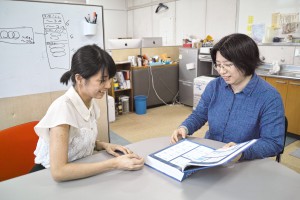Serial article ‘Research Interview’ ends this month due to my new at a newspaper company. I hope you enjoyed reading or got some useful information about Bioinformatics and Kinoshita & Obayashi lab.
Thanks to my interviewees, teachers, graduate and undergraduate students of the Lab, students of the School of engineering, and high school students at open campus.
I was unfamiliar with Bioinformatics and making translation into English when the serial started. My goal is that writing clear and accurate article, and I’ve tried to choose better words for translation.
Conversation with interviewees is the most important part of collecting. I could learn knowledge of research and also their way of thinking. I believe that quotations of their words make the article interesting and realistic. Which phrase did you favour?
There were some information I couldn’t state in the writings. “Some medicines are generally used before the mechanism of their effect.” Surprised to hear that, because I’ve thought medicines are used after how and why they work are revealed. Basic research plays an important role in science helping other researches with its information.
In one interview, the Prof told me that he intended to give students opportunity to think about diversity with question of genome. Some scientific studies make us thoughtful. (I think it’s like literature!)
Life information shows us thoughtful——serious problem. Genome reading or editing may alter our life, our partners’ life, and our babies’ life. Learning latest information and ethical problem is good way for reducing anxiety.
I wish I could publish articles more, but 5 interviews and 1 report are good enough for me; it’s my first serial of science and English. And I desire to write such articles again.
Thank you for reading.
September 30, 2015
Shizu YAMAGUCHI
September 25, 2015
By Shizu YAMAGUCHI
Assistant Prof Kazunori YAMADA started his life in Tohoku in this April. He thinks that Kinoshita Lab gives researchers latitude than usual.
“Strict restriction on research isn’t good for researchers,” he said. Students can study their research easier with teachers’ directions——some of restriction, especially during their job hunting. However, the Assistant Prof isn’t satisfied with easier and narrow circumstances.
Now he’s trying to decide his theme for research. The choices are analysis of proteins, research of medicine and protein, and study of genome techniques. You might feel hard to decide your university or theme of thesis like the researcher.
“I wish to inspire many Japanese people, giving them knowledge with my basic research.” His way of thinking is affected by his childhood.
He was born in 1982. 3 years have passed since he became a researcher. He spent his childhood in prosperity——Japan’s bubble economy (1986~1991). Japan’s economy took a turn for the worse at the beginning of 1990’s, as he was a teenager.
Some people told him that he’d better become a politician than a researcher, but he believes that science also has a good effect on economy and society of Japan. IT revolution in 2000’s was lead by American companies and research with Internet technology. He hopes his country plays an important role in tech revolution and economy like US.
He was a student of Faculty of Pharmaceutical Science. His doctoral thesis is about flu and he’s interested in medicine many years. However, he doesn’t want to be a pharmacist; he noticed that pharmacists don’t have many chances to use their knowledge, advising medical doctors about combination of drugs etc., during his part time job at a pharmacy.
✳ ︎✳︎ ✳︎
He starts his programming class this October. It’s one of SGU (Tohoku University’s Global Initiative) classes for exchange students. He visited Case Western Reserve University to join an academic meeting and see laboratories in this summer. He enjoyed 12-day visiting.
Many labs give researchers wide latitude like Kinoshita Lab. “It’s like a lot of Kinoshita Labs were there”, he said. He remembered that open and non-strict restriction laboratories were rare in Tokyo and Sendai.
He was impressed with diversity of researchers and students. While doctoral degree is quite important for research or job hunting, his/her age isn’t important one’s reputation in America. It’s different from Japanese companies placing importance on new graduates and younger age. He met 37 year-old doctoral student, professors maybe from China and Turkey.
Sometimes freedom of research is not good for students. At one of labs, 2 students studied the same part of research. This means the lab needs double time for the same research. The Assistant Prof thinks efficiency is also important for newest research.
The trip was good enough for him except for lacking Japanese cuisine. It brought him the possibility of collaborative research in the future. He said he wants to enhance listening skill in English before visiting US again.
I think that students should decide their research and laboratory from the point of view, ‘whether the lab respects your curiosity or not’.
Kazunori YAMADA
Ph. D. Science
Studied virology at Graduate School of Pharmaceutical Science, University of Tokyo
Started research bioinformatics in the latter half of Doctoral degree
Junior Research Associate at Riken (2010-2012)
Research Scientist at AIST (2012-2015)
Review: “Refinement of Amino Acid Substitution Matrix for Detecting Distant Relationships of Proteins” (Biophysics and Physicobiology, 55(3): 133-136, 2015) in Japanese
By Shizu YAMAGUCHI
September 16, 2015
It’s time for debate. New genome sequence techniques are developed these past few years. Associate Prof Ikuko MOTOIKE is a researcher of genome sequence and medical science. Gene information brings us various ethical issues. She’s cautious about sequencing her genome.
DEVELOPING TECHNIQUE
Sun Yat-sen University revealed their experiment that editing human embryos’ genome in this April. Nature and Science didn’t accept their report for reason of ethical problem. It was too early to carry out.
Today genome sequencing is widely used for medicine except for altering human embryo(=life information). The Associate Prof is a member of sensing physical data research and a project using genome information for preventive and individual care.
She said, “It’s important everyone can maintain their health” against the aging society in Japan. Some gene information tells proper kind of anticancer agents to patients. The project aims to contribute to promoting preventive medicine like this, by analyzing genome.
Thanks to rapid innovation, we can get gene information with 1-day sequencing or take analyzing service less than 200 dollars (some private companies’ service). However, the technique still has room for doubt about its accuracy.
LACK OF DEBATE
Do you want to know whether you have an incurable disease? You might be unable to decide ‘yes’ or ‘no’. What do you think about disease rate in the future? Which test will you take, for only curable disease or for all possibilities? Ironically, the imprecision of sequence makes you a little relaxed; you don’t have to concern seriously.
The UK accepted the “three-parent” law about 6 months ago. Reproduction technique has been developed, and we Japanese need to debate more active. The Associate Prof thinks many people don’t learn ethical problems gene techniques will cause. For example, setting a class about latest science and ethical problem at school can be one solution.
TAKE YOUR CHOICE
The technique may affect your life. Perhaps some gene information plays an important role when you choose health insurance. The US adopted GINA (Genetic Information Nondiscrimination Act) in 2008, to prevent discrimination based on genome information at insurance or employment.
Ethical issues involve couples in serious matter. Some gene variants have no bad influence in one person, but they cause a problem in two persons. When both father and mother have this kind of variants at the same gene, their baby will have disorder. After knowing that, can you decide to marry him/her or give a birth?
Reading genome is useful but complicated. Some scientists are passive to analyze their gene, and others are not. She’s afraid that problems with her maternal inheritance or dominant gene will be revealed. “I don’t have confidence to tell my children the problem”, she said. It’s hard to judge children’s age for adequate understanding. Children are quite clever students.
AS A SCIENTIST
She hopes that she provides people with latest and accurate knowledge to makes them considerable; getting rid of overestimating or too much fear about genome issues by giving knowledge. New gene techniques help us choice proper medicine, decide when to start treatment etc.
At the same time we should remember life habit forms our health of body and mind. Genome information is certainly blueprint of life, however, it doesn’t control entire health.
Bioinformatics holds ethical issues and influence on next generation. We no longer get back to time before gene techniques developed. The Associate Prof, an expert on informatics, is trying to impart knowledge to other people for their wiser thinking. “I’ll give you information without bias, and wish you’ll consider ethical issues by yourself.”
(Interviewee’s comment)
I thought her consideration about the issues came from her life with children. Ethical problem, medical matters—many good materials lie in gene science for classes of morality. I want to learn more, and hope my knowledge will be useful information for me.
Ikuko MOTOIKE
Ph.D. Science
Special Postdoctoral Researcher at JSPS
Assistant Researcher, Assistant Professor at Future University Hakodate
Researcher of Innovative model of biological processes and its development at JST
Research Fellow at Kyoto University
Project Assistant Professor at Graduate School of Information Science, Tohoku University
By Shizu YAMAGUCHI
Tohoku University held 2-days open campus of 2015, on July 28th and 29th. I visited one of its biggest sites, the School of Engineering, for the first time.
Officials said about 8,000 people came to the event at the School of Engineering.
The School lies in Aobayama. There were some tents for guidance outside, and a sign showed laboratories’ sections to visitors. They have 7 main subjects —Mechanical and Aerospace Engineering (famous for spacecraft ‘Hayabusa’), Electrical Information and Physics Engineering etc. Kinoshita & Obayashi Laboratory is one of Electrical Information and Physics Engineering, with the theme of medical engineering.
It was difficult to visit all exhibitions; surprisingly more than 60 sections were inside. A graduate student from Kyoto Univ. said the open campus is a grand-scale event comparing with its of his university’s. It’s so crowded all the time.
I think there’s no vacant section in the afternoon. Lab’s students explained about research for visitors, around 10 audiences.
A high school student from Niigata Pref. told me, “ I didn’t know the School of Engineering had several majors, especially medical engineering.” Visitors could take an alcohol patch test at Kinoshita Lab’s section. The test showed us tolerance to alcohol controlled by genome information. Bioinformatics places between engineering and medical science.
Visitors were high school students, children, adults and 3rd-grade undergraduates. The undergraduates participated the event to decide their Lab from next year.
Then I went to robotics and intelligence system exhibition. Fun to see around—machines I’ve never seen displayed, and I could try to use some of them. (Unfortunately I didn’t have enough time.)
A student explained to me his research for enhancing character recognition skill of 360-degree camera. Finding out certain characters from whole image is more difficult than simple reading.
I was back after listening to the explanation. Students of Kinoshita Lab had started the test and presentation for new visitors. Some told teenagers about admission test. “They give me both clear answers and their opinion to my question”, said a high school student.
I think that it would be difficult to decide a department of science without listening explanation if I were a high school student. I believe every visitor can enjoy and learn about research of a large number of laboratories!
By Shizu YAMAGUCHI
July 24, 2015
What do you think about genome sequences? Some people might imagine analyses of huge amount of data with A, T, G, C. Genome means whole bioinformation of human, but it doesn’t control all of our health. Protein also plays an important role in our cells.
Assistant Prof Hafumi Nishi’s research focuses on protein and genome. It’s possible that studying both genome and protein in Kinoshita Lab.
“Distribution of single nucleotide variants on protein-protein interaction sites” She won the 15th Young Scientist Award by PSSJ. She researched where and how single nucleotide variants exist from the structural point of view. There are ordinary and unusual patterns of variants.
Cells contain many proteins inside. Protein is a folded peptide chain consisted of amino acid. Chains of proteins contact each other in a cell, and the surface is called interaction site. Center of the site promotes chemical reaction while its edge doesn’t do so much.
Genome variants mean differences between individual genome and reference genome. Reference genome has standard arrangement for comparing with other genome data. Common variants, many people are having, are usually on the edge of interaction site. If common variants were on center of the site, many people would be suffered from disorder cause of variants.
She confirmed this tendency by analyzing genome data on her hypothesis that common variants are on edge and rare variants exist randomly on the interaction site.
Then, how about unusual cases?
She watched one unique variant that arginine changed into glutamine. It’s one example of 20 rare variants. Both molecules are amino acid, but they have quite different construction. Thus, the alternation may have remarkable influence than usual. Additionally, many people have this variant and it lies on center of the site.
She noticed that other scientist’s research showed the answer. Proteins get stronger in the plural than in the single. A cell contains many proteins, and weakness of binding due to the variant doesn’t have bad influence on humans’ body.
She showed that cells overcome risky genome variant. Because she researched both genome and protein, she could reach the conclusion.
She says, “genome is basic information of our body, and proteins are dwarf working in our cells”.
Hafumi NISHI
Doctor of Science
Researcher at Nagoya University (2009-2010)
Postdoctoral fellow at NIH, America (2010-2012)
Contract Assistant Professor at Yokohama City University (2013)
JSPS Research Fellow at Yokohama City University (2013-2014)
Assistant Professor at Tohoku University (2014-)
By Shizu YAMAGUCHI
July 7, 2015
I knocked on Professor room’s door. Prof KINOSHITA and I started talking in the hot room in the afternoon.
–Is the term for one research determined in advance?
My beginning question seemed to be a bit surprising for him. He said the term depends on research-plan and its budget rather than length of time. And some researches may produce unexpected results out of their plans.
Some students at non-scientific department relate researchers to workers wearing white coats in a national or private institute, and they’re sometimes unaware that professors are also researchers, and labs in universities are important institutes.
Well I felt a bit sweaty. Our conversation turned to his classes at the School of Engineering.
MEANING OF A CLASS
Then I thought in my mind I’ll ask about links between his research and class, but he asked before me, “ Do you think lectures are really useful for students? ” His question reminded me of my experiences as a student.
Certainly some classes were interesting. For instance, guides for special education, analyses of literature works. Those provided me with new points of view made me thoughtful. Compared to those, I wanted to take a nap in dull lectures; what all I did was only hearing Prof’s text reading for 90 minutes.
Around 2 decades ago, teachers of universities had more freedom to give lectures. Prof Kinoshita remembers his first class clearly because his teacher was very late and said, “Why are you sitting here?” They thought that students studied by themselves not depending on lectures too much. Prof Kinoshita thinks that text-learning classes should be more flexible; one student needs 1 year to understand a theory though another student takes only 1 month.
–Then what do you want to give your students at your class?
Air conditioner has cooled the room. The wind cleared my head.
He’d struggled how to improve his lecture for first 2 years. “Should I teach them algorithm in between biology and informatics? Is it useful for them? Anyway, what are they thinking about?” Finally he determined his style giving them hints for new ways of thinking with issues lie in genome science.
Genome science is classified as biological science (not engineering) , actually it’s good material to learn biodiversity.
LEARNING ABOUT DIVERSITY
In the past we had inspection of color blindness (called ‘color-vision deficiency’ in Japan today) at elementary school. However, the inspection is now for only applicants. Some people were afraid that inspection in classes would cause discrimination (I can’t understand this idea). The Prof says, “I believe it’s one of diversity that we can read from genome information, NOT deficiency.” Various patterns of color vision exist, both less and more than usual.
He told me an example of color universal design. Lines of Tokyo Metro Subway were showed in colored circles before. Now lines’ initials are written in each colored circle. Thus color-blind people can also distinguish lines. The topic of genome became close to me, as I’d seen the signs many times. “Students would have no idea if a topic were not close to them.” His words were persuasive.
Natural selection and biodiversity, considering these 2 themes is complicated related to issues of bioethics and medical care. However, you can consider it easier with Pokémon video game! I was a little embarrassed to hear that. Because I’d played the piano instead of games in my childhood, and I couldn’t image the game with genome and diversity topics.
Game player hybridize Pokémon, and choose stronger one, so Pokémon are under selection pressure from player. This individual-selecting pressure is so high in a very short term like playing a game. While in the real, people hardly choose and desert their children (=low pressure). Diversity, needs some generations to gain ability to adapt to environment, is not nurtured in a high-pressure world; dinosaurs were very strong in a specific period, but weak in the climate change.
The Prof questioned students meaning of studying genome modification. Genome information (including 30,000 genes) are almost common among human. Genes’ problems come from 0.1% of genome modification, and there’s no clear boundary between disorder and health.
He introduced 2 movies to them, ‘Extraordinary Measures’ (2010), and ‘Gattaca’ (1997). The former is a documentary that a father strived to cure his serious disease children, and the latter is a SF film that people are classified upper and under class by genome editing. Students described their opinion about themes ‘effort and talent’, ‘price of medicine and human’, etc.
PRICE OF LIFE
He said paying fees for treatment is a social problem that we cannot ignore. A medicine for rare disease might need 8 million dollars to develop par one patient. How much do you pay to survive or save someone? Japanese public insurance system is one solution (I think it’s the best way for medical expense, because all people cannot deny falling sick). The Ministry of Health, Labour and Welfare designates rare diseases for public support.
I got relieved for a moment, but gloomy memory came into my mind. Last summer a couple answered my interview. They lost their young sons by intractable disease that needs more than 800 thousand dollars for transplant surgery in America.
AT THE END OF INTERVIEW
Prof Kinoshita is trying to give students unique idea at his class. “Research means discovery, and I want them to get a clue for their study before starting research.”
The room has completely become cool and comfortable. I felt like taking his class for thinking genome problems. I opened the door after saying thank you –a sticker of cat’s silhouette above the doorknob, since he loves cats. The interview, or his class, was over.
Kengo KINOSHITA
PH.D. in Chemistry
GSC research associate at Osaka university (2000-2001)
Assistant Professor at Yokohama City University (2002-2003)
Visiting Associate Professor at Institute for protein research (2014.1-9)
Associate Professor, Institute of Medical Science at University of Tokyo (2004/10-2009)
Professor, Graduate School of Information Science at Tohoku University (2009.10-)
By Shizu YAMAGUCHI
June 23, 2015
The associate professor Takeshi OBAYASHI tries to solve his problem “what are human beings? ” using way of genome analysis. He and his colleagues developed an open database system that shows gene coexpression networks. It helps other researchers choice patterns of genes for their research.
INTEREST IN THE PAST
He had studied about plants as a graduate school student. When he did mouse vivisection first, organs’ minuteness made an impression. However, he didn’t want to kill mice everyday at the same time. Some of animal researches, rapid developing vaccine or medicine, confront urgent or serious disease; recently he considers plants research to be helpful in solving social problems, such as food shortage and the gap between rich and poor in the long term.
“Plants are incredibly flexible and they can alter their bodies and properties depending on any new situation. That’s impossible for us human or other animals,” the associate prof. said excitedly.
Today we restart our working or studying after the Golden Week holidays. Then I start reporting researches of Kinoshita and Obayashi Lab, Graduation School of Information Sciences, Tohoku university, as a new writer.
The laboratory mainly analyzes the huge amount of human genome data, to find new rules of bioinformatics. Analyzing, and proposing a unique viewpoint are also good ways for reporting. Can I apply this ideas to my articles?
Actually I wasn’t the Graduation School student; my graduation thesis of department refers to Japanese literature. However, I’m curious to learn what the lab researches or discovers, and you’ll be able to read clear articles.(Understanding the research is challenging for me.)
I’m looking forward to your visiting our web page.
Thank you for reading.
2015.5.7
(ShizuYAMAGUCHI)
- «
- <
- 1
- >
- »



